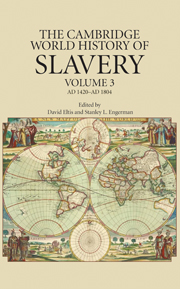Book contents
- Frontmatter
- Contents
- List of Maps, Figures, and Tables
- Contributors
- Series Editors' Introduction
- 1 Dependence, Servility, and Coerced Labor in Time and Space
- PART I SLAVERY IN AFRICA AND ASIA MINOR
- PART II SLAVERY IN ASIA
- PART III SLAVERY AMONG THE INDIGENOUS AMERICANS
- PART IV SLAVERY AND SERFDOM IN EASTERN EUROPE
- PART V SLAVERY IN THE AMERICAS
- 13 Slavery in the Atlantic Islands and the Early Modern Spanish Atlantic World
- 14 Slavery and Politics in Colonial Portuguese America: The Sixteenth to the Eighteenth Centuries
- 15 Slavery in The British Caribbean
- 16 Slavery in the North American Mainland Colonies
- 17 Slavery in the French Caribbean, 1635–1804
- 18 Slavery and the Slave Trade of the Minor Atlantic Powers
- PART VI CULTURAL AND DEMOGRAPHIC PATTERNS IN THE AMERICAS
- PART VII LEGAL STRUCTURES, ECONOMICS, AND THE MOVEMENT OF COERCED PEOPLES IN THE ATLANTIC WORLD
- PART VIII SLAVERY AND RESISTANCE
- Index
18 - Slavery and the Slave Trade of the Minor Atlantic Powers
from PART V - SLAVERY IN THE AMERICAS
Published online by Cambridge University Press: 28 September 2011
- Frontmatter
- Contents
- List of Maps, Figures, and Tables
- Contributors
- Series Editors' Introduction
- 1 Dependence, Servility, and Coerced Labor in Time and Space
- PART I SLAVERY IN AFRICA AND ASIA MINOR
- PART II SLAVERY IN ASIA
- PART III SLAVERY AMONG THE INDIGENOUS AMERICANS
- PART IV SLAVERY AND SERFDOM IN EASTERN EUROPE
- PART V SLAVERY IN THE AMERICAS
- 13 Slavery in the Atlantic Islands and the Early Modern Spanish Atlantic World
- 14 Slavery and Politics in Colonial Portuguese America: The Sixteenth to the Eighteenth Centuries
- 15 Slavery in The British Caribbean
- 16 Slavery in the North American Mainland Colonies
- 17 Slavery in the French Caribbean, 1635–1804
- 18 Slavery and the Slave Trade of the Minor Atlantic Powers
- PART VI CULTURAL AND DEMOGRAPHIC PATTERNS IN THE AMERICAS
- PART VII LEGAL STRUCTURES, ECONOMICS, AND THE MOVEMENT OF COERCED PEOPLES IN THE ATLANTIC WORLD
- PART VIII SLAVERY AND RESISTANCE
- Index
Summary
INTRODUCTION
In the history of the Atlantic, the literature on the French, British, Spanish, and Portuguese empires continue to dominate the body of historical writing. Yet the Atlantic activities of these nations differed considerably from those of the smaller ones. The larger nations could create their own section in the Atlantic economy, whereas this was impossible to achieve for the smaller nations. Rather than building up a network of transatlantic migration movements of both Europeans and Africans and integrating these with the trade in European, African, and New World goods, the smaller nations first established trade connections on the African coast, mainly trading in produce. Attempts at entering the transatlantic slave trade were more difficult, and the same applied to the trade in European migrants. Only the Dutch and the Danes were able to establish colonies in the West Indies for any length of time, and only the Dutch and the Swedes established colonies of settlement in mainland North America, albeit for a very short period.
The oldest Atlantic empires are those of the Spanish and the Portuguese, which, in spite of their synchronous development, were radically different from one another. The Spanish Empire in the New World was self-contained, whereas Portuguese Brazil was geared to producing products for export destined for Europe and Africa. The Spanish created a string of settlement areas in the New World in which European settlers and the autochthonous population mixed. Exports to Europe were limited to high-value products such as precious metals.
- Type
- Chapter
- Information
- The Cambridge World History of Slavery , pp. 450 - 476Publisher: Cambridge University PressPrint publication year: 2011

